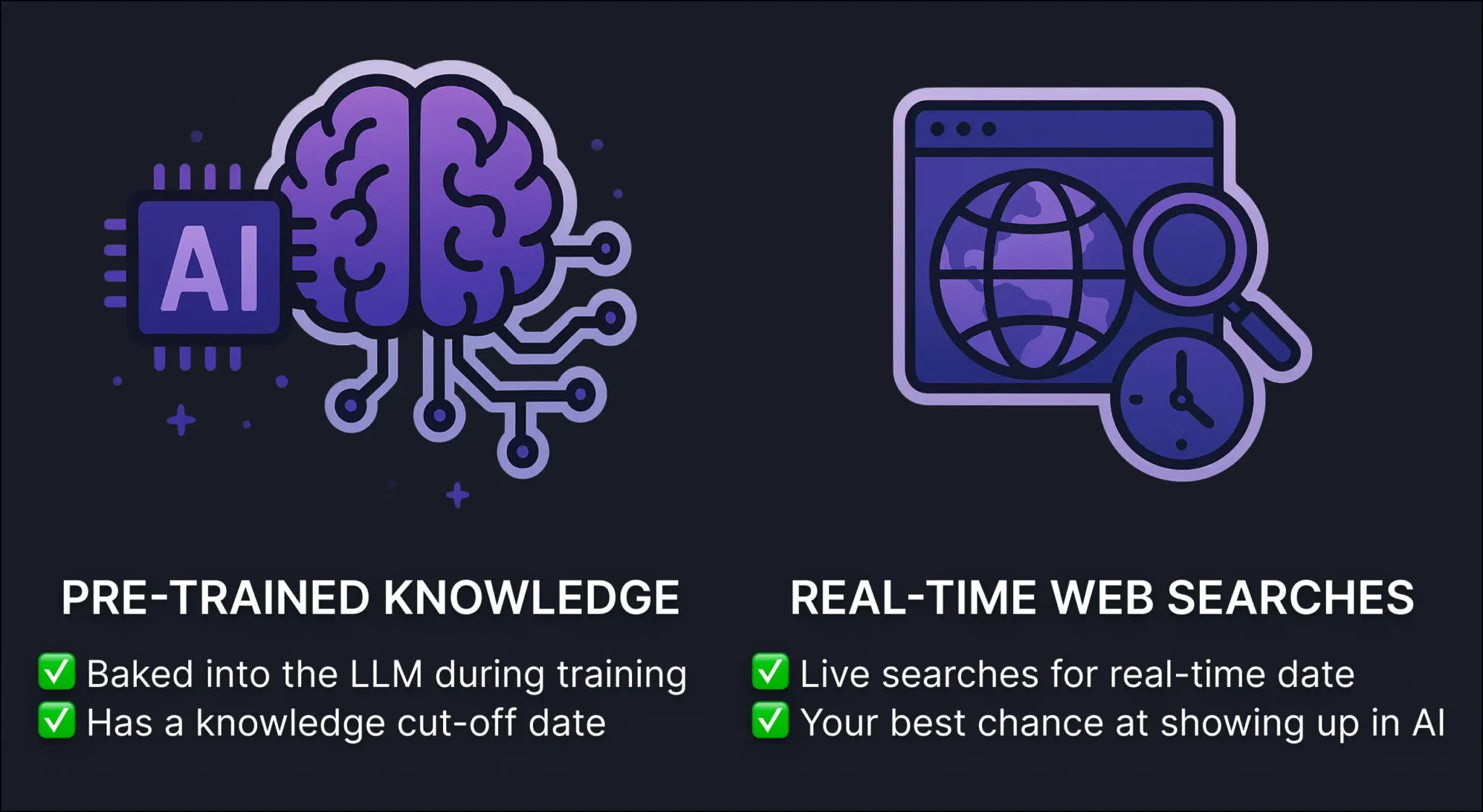Generative Engine Optimization: The Complete AI SEO Guide

AI is changing how people find information online, if your business is online you can’t afford to fall behind. AI SEO, Generative Engine Optimization or GEO now goes beyond keywords, putting the focus on content quality and relevance for smarter search engines that are powered by AI, think ChatGPT or Google’s AI Mode.
This new way of searching calls for a new way of optimizing beyond SEO. In this post, we’ll explain Generative Engine Optimization and how to create content that helps brands in AI search results; where it matters most to earn a user’s trust. Learn how to keep your business ahead as search engines become smarter.
Key Takeaways
- GEO gets you cited, not just ranked. While traditional SEO focuses on search rankings, Generative Engine Optimization optimizes your content to be quoted and recommended by AI engines like ChatGPT, Google AI, and Perplexity.
- AI-referred traffic converts better. When AI engines cite your content, visitors arrive pre-qualified and engaged, leading to higher conversion rates and longer time on site compared to traditional search traffic.
- Success requires both technical and content optimization. Effective GEO combines clear, data-rich content with technical elements like schema markup, fast loading speeds, and structured headings that help AI engines find and understand your expertise.
What is Generative Engine Optimization (GEO)
Generative Engine Optimization (GEO) is the practice of creating content that AI engines like ChatGPT, Google AI Mode, and Perplexity want to cite and recommend. Think of it like AI SEO, instead of just trying to rank in search results, you’re optimizing to become the trusted source that AI quotes when answering questions.
There are also a few other terms people use for GEO since there is no industry standard, but the idea is the same: Answer Engine Optimization, LLM Engine Optimization, and Generative Search Optimization.

Here’s the key difference:
Traditional SEO focuses on getting clicks from search engine result pages. You optimize for keywords, build backlinks, and chase rankings to drive traffic to your site.
AI SEO focuses on getting citations in AI-generated answers. You create content so valuable and clear that AI engines reference you directly when responding to user questions.
Why this matters now:
Search behavior is changing fast. People are asking AI engines longer, more conversational questions like “What’s the best email marketing strategy for a small bakery?” instead of typing “email marketing tips” into Google.
When AI answers these questions, it pulls information from trusted sources across the web. GEO ensures your content becomes one of those trusted sources.
The core principles that make content AI-friendly:
- Clear, direct answers to common questions in your field
- Specific data and examples that AI can confidently cite
- Natural, conversational language that matches how people actually search
- Expertise signals like case studies, original research, and detailed explanations
- Structured content with clear headings and logical flow
The bottom line: GEO doesn’t replace traditional SEO – it builds on it. You still need good technical SEO to help AI engines find your content. But once they find it, GEO tactics determine whether they’ll actually cite and recommend you.
Think of it as earning AI’s trust, not just its attention.
Traditional SEO vs. GEO
The rules of the game have changed. While traditional SEO and GEO both aim to boost your content’s visibility, they play by completely different rulebooks.
Here’s the key difference:
Traditional SEO is all about getting clicks. You optimize for keywords, build backlinks, and chase rankings to drive traffic from search engine results pages. Success means appearing in position 1-3 on Google. This requires users to read through results to find their own answers.

GEO is about getting cited. You create content so valuable and clear that AI engines quote you directly in their answers. Success means being the source AI trusts and references.

Think of it this way:
- Traditional SEO = Being the best restaurant review site
- GEO = Being the restaurant that gets recommended in the review
What this means for your strategy:
Traditional SEO tactics still work and matter. Especially since many Large Language Models (LLMs) use Google or Bing data when searching. You need solid keyword research, quality backlinks, and technical optimization. But GEO adds a new layer:
- SEO asks: “Will this help me rank?”
- GEO asks: “Will AI want to quote this?”
The smart approach? Don’t choose between them. Do both. Optimize your content to rank well in search engines (so AI can find it during web searches) AND structure it so AI wants to cite it in responses.
GEO doesn’t replace SEO – it makes your SEO more powerful by turning your ranked content into quotable, trustworthy sources that AI engines love to reference.
If you want a step-by-step framework for mastering both GEO and classic SEO, check out our full SEO course for subscribers.
The Role of AI in Search Engines
AI has completely transformed how search engines work. Instead of just matching keywords, they now understand what you actually mean when you search.
Here’s what changed:
Search engines used to be like librarians with a card catalog. You had to use the exact right words to find what you needed. Now they’re more like smart assistants who understand context and intent.
AI powers these major improvements:
- Natural language understanding – You can ask “What’s the best pizza place near me that’s open late?” instead of typing “pizza restaurant hours location”
- Intent recognition – AI figures out whether you want to buy something, learn something, or find a specific website
- Contextual results – Search engines consider your location, search history, and current trends to give you relevant answers
- Direct answers – Instead of just showing links, AI can summarize information and answer questions directly
Why this matters for your content:
The old approach of stuffing keywords into content doesn’t work anymore. AI can spot unnatural language patterns and prefers content that reads naturally.
What AI looks for now:
- Clear, helpful information that directly answers questions
- Content written in natural, conversational language
- Comprehensive coverage of topics, not just keyword targeting
- Expert insights and unique perspectives that add real value
The bottom line: AI has made search engines smarter at understanding both what people want and what content actually delivers value. This means your content needs to be genuinely helpful, not just optimized for robots.
Create content that serves real people with real problems, and AI engines will recognize and reward that quality.
How to Optimize Content for LLMs
Large Language Models like ChatGPT, Claude, and Gemini are becoming the go-to sources for quick answers. If you want your content to show up in their responses, you need to think differently about how you create and structure it.
Here’s exactly how to make your content irresistible to AI engines.
How AI Actually Finds Your Content
Before diving into optimization tactics, you need to understand how AI engines actually get their answers. This knowledge changes everything about your content strategy.

AI engines get information in two main ways:
- Pre-trained knowledge – Information they learned during training (but this has a cutoff date)
- Real-time web searches – Live searches they perform when they need current information
Here’s what this means for you:
When someone asks ChatGPT “best email marketing tools 2025,” it doesn’t just guess. It searches the web in real-time, analyzes the results, then creates an answer based on what it finds. This is why organic mentions of your brand are also so important.
The search engines AI uses:
- ChatGPT primarily uses Bing for web searches
- Perplexity uses multiple search engines and shows its sources
- Google’s AI uses Google’s own search results
- Claude can search the web but often relies on training data
Why this matters: If you want to show up in AI answers, you need to rank well in the search engines that AI uses. For ChatGPT (the most popular), this means optimizing for Bing is crucial.
Action steps:
- Submit your site to Bing Webmaster Tools
- Check how your content ranks on Bing for key terms
- Optimize for Bing’s ranking factors (they value exact-match domains and older content more than Google)
- Monitor which sources AI engines cite for your topic area
Quick test: Search your main topic on Bing and see if you appear in the top 10 results. If not, that’s your first priority.
Make Sure AI Engines Can View Your Site
Don’t accidentally lock AI engines out of your content. Many websites block AI crawlers without realizing it, which kills any chance of getting cited.
Check your robots.txt file to ensure you’re not blocking important AI crawlers like:
- GPTBot (OpenAI/ChatGPT)
- Google-Extended (Google’s AI training)
- Claude-Web (Anthropic’s Claude)
If you haven’t specifically blocked AI crawlers they are likely able to access your website.
Quick audit: Go to yoursite.com/robots.txt and look for “Disallow” rules that might be blocking these crawlers. If you see them listed, you’re preventing AI engines from accessing your content.
The smart approach: Allow AI crawlers to access your public content. The benefits of getting cited by AI engines far outweigh any concerns about content scraping. When AI quotes your expertise, it drives qualified traffic back to your site. I know it’s hard to let a robot “steal” your content but the end goal is to have people find your website or service.
Exception: Only block AI crawlers if you have specific business reasons to protect your content. For most businesses, blocking AI access means missing out on free exposure and citations.
Write Like You’re Teaching a Friend
LLMs love clear, direct explanations. Skip the fancy jargon and write like you’re explaining something to a smart friend who’s new to the topic.
Here’s your action plan:
- Write sentences under 20 words when possible
- Define every technical term the first time you use it (example: “Lead magnets – free resources you offer in exchange for email addresses”)
- Start each paragraph with your main point, then add supporting details
- Use the “So what?” test – after every statement, ask yourself why it matters
Quick test: Read your content out loud. If you stumble or feel confused, rewrite those sections. You can use the rewriter tool on RightBlogger to quickly rewrite sections with instructions.
Structure Your Content for Easy Parsing
AI models scan your content looking for clear patterns and logical flow. Make their job easy with smart formatting.
Copy this structure:
- H2 headings that include your target keyword naturally (“5 Email Marketing Strategies That Boost Open Rates”)
- H3 subheadings that preview the specific benefit (“Strategy 1: Personalize Your Subject Lines”)
- Bulleted action steps under each strategy
- Bold key phrases that summarize important points
Pro tip: Use numbered lists for processes and bulleted lists for tips or features. AI models pull from these formats constantly.
Include Data and Statistics

AI engines love to cite specific numbers and research findings. When you include concrete data, you’re much more likely to get quoted.
Try to do this every time:
- Add at least one statistic per 300 words of content
- Source your data with links to the original study
- Put numbers in your headings when relevant (“3 Ways to…” or “50% Increase in…”)
- Create your own simple surveys or track your results to generate original data
Template to follow: “According to [Source], [specific statistic]. This means [what it means for your reader]. Here’s how to apply this: [actionable step].”
If you also have an audience, you can poll them with questions to create original data and statistics. This is a great way to have something on your blog that only you have.
Answer Questions Directly
Think about the questions your audience asks, then answer them head-on in your content.
Your step-by-step process:
- List 10 questions your customers actually ask you
- Answer each one in 1-2 sentences at the start of relevant sections
- Use question-style subheadings (“How Long Does Setup Take?” or “What Tools Do You Need?”)
- Create a FAQ section at the end of longer articles
Example format: “How long does email automation take to set up? Most email automation sequences can be set up in 2-3 hours. Here’s the breakdown: [then explain the process].”
Optimize for Context and Intent
LLMs are getting better at understanding what users really want, not just what they type. Help them connect your content to user intent.
Follow this keyword strategy:
- Use your main keyword in the title and first paragraph
- Include 3-5 related terms naturally throughout (use tools like AnswerThePublic or RightBlogger’s People Also Ask tool to find these)
- Add semantic keywords that AI associates with your topic
- Write how people actually search (“best email marketing tool for small business” not just “email marketing”)
Content depth checklist:
- Explain the “why” behind each tip
- Include common mistakes to avoid
- Mention related tools or resources
- Connect to broader marketing concepts
Make Your Content Quotable
AI models often extract specific phrases or sentences to include in their responses. Make yours worth quoting.
Write quotes using this formula:
- Specific claim + supporting number + clear benefit
- Example: “Segmented email campaigns generate 250% more revenue because they target specific customer needs instead of blasting generic messages.”
Create quotable sections:
- Start paragraphs with actionable statements
- Use “According to our research…” or “Studies show…”
- Write takeaways as standalone sentences that make sense alone
- Bold your best insights
Build Topic Authority
LLMs recognize expertise signals across your entire site, not just individual pages.
Your 90-day authority plan:
- Week 1-2: Create a pillar page covering your main topic comprehensively
- Week 3-6: Write 8-10 supporting articles that dive deep into subtopics
- Week 7-12: Add case studies, tutorials, and comparison guides
- Ongoing: Update content monthly with new data and examples
Internal linking strategy:
- Link to related articles using descriptive anchor text
- Create a “Related Reading” section at the end of each post
- Build topic clusters by linking all related content together
Authority signals to include:
- Author bio with credentials (important for Google’s E-E-A-T guidelines)
- Client testimonials or case studies
- Industry certifications or awards
- Links to your appearances on podcasts or other sites
Monthly maintenance checklist:
- Update statistics with newer data
- Add recent examples or case studies
- Check that all links still work
- Add new sections based on reader questions
The key to LLM optimization isn’t gaming the system – it’s creating genuinely helpful content that deserves to be recommended. Start with one piece of content this week and apply these tactics. Your AI visibility will improve within 30 days.
Benefits of Generative Engine Optimization
GEO isn’t just another marketing buzzword – it delivers real, measurable results that can transform how people discover your business online.
Here’s what you can expect when you optimize for AI engines:
Get Found More Often (Enhanced Content Visibility)
The most immediate benefit? More people will discover your content. When AI engines quote or reference your content in their responses, you’re essentially getting a recommendation from a trusted source.
The numbers speak for themselves:
- Lower ranked websites report visibility increases up to 115% after implementing GEO
- Content optimized for AI gets featured in rich snippets and “People Also Ask” sections more often
- Your brand shows up in AI responses even when people don’t search for you directly
Here’s why this happens: AI engines love content that’s detailed, well-structured, and includes specific data. When you add citations, statistics, and clear explanations to your content, you’re giving AI exactly what it needs to confidently reference you.
Build Stronger Connections (Improved User Engagement)
GEO creates a better experience for your audience by delivering exactly what they’re looking for.
Why engagement improves:
- AI delivers your content to people at the exact moment they need it
- Users trust AI recommendations, so they arrive pre-qualified and interested
- Your content appears alongside the answer to their specific question
Real-world example: Instead of someone finding your “email marketing guide” through a generic search, they discover it when AI quotes your specific tip about subject line personalization in response to their question “how do I get more people to open my emails?”
Stay Ahead of the Curve (Future-Proof Your Strategy)
Search behavior is changing fast. People are asking longer, more conversational questions and expecting direct answers.
This change will affect affiliate blogs a lot. We suggest selling a product or service you promote. This way, you can compete in spaces that do not depend on referral commissions. This is especially important if you rely on SEO traffic.
What’s happening:
- Voice search and AI assistants are making queries more natural (“What’s the best email tool for a small bakery?” vs “email marketing software”)
- Users want answers, not just links to websites
- Mobile searches are increasingly conversational
Your advantage: Businesses that adapt to GEO now will capture market share while competitors are still focused only on traditional SEO rankings.
The competitive edge: Smaller businesses can compete with industry giants by creating highly specific, valuable content that AI loves to cite. You don’t need the biggest marketing budget – you need the most helpful content.
Action step: Start tracking how often your content gets mentioned in AI responses. Tools like ChatGPT, Perplexity, and Google’s AI features show their sources – monitor whether you’re appearing for queries related to your expertise.
Tools to help track AI brand mentions:
The businesses winning with GEO aren’t necessarily the ones with the most resources. They’re the ones creating genuinely useful content that deserves to be recommended.
Technical Aspects of Generative Engine Optimization
Getting the technical foundation right is non-negotiable for GEO success. AI engines are picky about which content they can easily access and understand. If your site has technical issues, AI will simply skip your content and cite your competitors instead.
Here’s what you need to nail:
Make Your Content AI-Readable with Schema Markup
Schema markup is like giving AI engines a roadmap to understand your content. It’s structured data that tells AI exactly what your content is about. If you are using a CMS like WordPress typically your WordPress theme will handle some of these aspects.
Why this matters: When ChatGPT or Google’s AI searches for information about “email marketing ROI,” schema markup helps them instantly identify that your article contains statistics, definitions, and actionable tips – not just random text.
What to implement:
- Article schema for blog posts and guides
- FAQ schema for question-and-answer sections
- Review schema for product or service reviews
- Organization schema for your business information
Quick action steps:
- Use Google’s Schema Markup Helper to generate code for your content
- Add FAQ schema to pages with common questions
- Test your markup with Google’s Rich Results Test tool
- Priority: Start with your most important pages first
The payoff: Content with proper schema markup appears in rich snippets 30% more often than content without it.
Speed Up Your Site (AI Engines Are Impatient)
Slow sites get skipped by AI crawlers. If your page takes 5+ seconds to load, AI engines will move on to faster competitors.
Target benchmarks:
- Page load time under 3 seconds
- Mobile-friendly design (responsive)
- Core Web Vitals scores in the “Good” range
Quick wins:
- Compress images before uploading (aim for under 100KB each)
- Use a Content Delivery Network (CDN) like Cloudflare
- Choose a reliable hosting provider
- Remove unnecessary plugins or scripts
Overall, you’ll want to keep your site simple and loading quickly, rather than focusing on features that will bog down your site’s experience.
Test your speed: Use Google PageSpeed Insights to check your current performance and get specific improvement recommendations.
Mobile matters: Over 61% of web traffic happens on mobile devices. If your site doesn’t work well on phones, AI engines will prioritize competitors who do.
Write Better Meta Tags and Structure Your Data
Meta tags and structured data are like the table of contents for your content. They help AI engines quickly understand what each page covers.
Essential meta elements:
- Title tags that clearly describe your content (under 60 characters)
- Meta descriptions that summarize your page’s value (under ~155 characters)
- Header tags (H1, H2, H3) that organize your content logically
- Alt text for images that describes what they show
Best practices:
- Include your main keyword in the title tag naturally
- Write meta descriptions that make people want to click
- Use header tags to create a clear content hierarchy
- Keep URLs short and descriptive
Example of good structure:
H1: How to Increase Email Open Rates in 2025
H2: Why Open Rates Matter for Your Business
H3: The Cost of Low Open Rates
H3: Benefits of Higher Engagement
H2: 7 Proven Strategies to Boost Opens
H3: Strategy 1: Personalize Your Subject LinesQuick audit: Check your top 10 pages to ensure they all have unique, descriptive title tags and meta descriptions. Missing or duplicate meta tags confuse AI engines.
The technical foundation matters because AI engines process thousands of pages per second. Make it easy for them to understand and cite your content by following these technical best practices.
Start with schema markup and site speed – these two changes alone can dramatically improve your chances of being featured in AI responses.
Measuring Success in Generative Engine Optimization
Unlike traditional SEO where you check your Google rankings, GEO success is about tracking how often AI engines quote your content and send you qualified traffic.
Here’s what to measure and how:
Track Your AI Mentions
The core metric for GEO is citation frequency – how often AI engines reference your content when answering questions.

Start with manual testing:
- Ask ChatGPT, Perplexity, and Google’s AI about your main topics weekly
- Document when your content gets cited or mentioned
- Note which competitors get cited instead of you
Key metrics to watch:
- How often you get cited across different AI platforms
- Which pieces of content get quoted most
- Whether mentions are increasing or decreasing over time
Monthly check: Test 5-10 relevant questions and track your citation rate. This gives you a baseline to improve from.
Set Up Analytics Tracking
Your existing analytics tools can track AI-driven traffic with some simple adjustments.
Google Analytics 4 setup:
- Create custom channel groupings for AI chatbot traffic
- Monitor referral traffic from AI platforms
- Track engagement metrics (time on page, bounce rate)
What to monitor:
- Traffic volume from AI sources
- How AI-referred visitors behave on your site
- Conversion rates from AI traffic vs. traditional search
Quick win: AI-referred visitors often have higher engagement because they’re pre-qualified. Track this to prove GEO’s value. Just keep in mind that all LLMs will not send traffic that is trackable.
Review and Adjust Monthly
Use your data to guide content decisions and strategy changes.
Monthly review process:
- Check citation frequency – Are you getting mentioned more or less?
- Analyze top-performing content – What formats and topics work best?
- Identify gaps – Where are competitors getting cited instead of you?
- Plan next month’s content based on what you learned
Success indicators:
- Increasing citation frequency over time
- Higher engagement from AI-referred traffic
- More branded searches (people looking for you specifically)
Start simple: Pick 5 questions your customers ask and see if AI mentions your content. Build from there as you get more data.
Common Mistakes to Avoid in GEO
Even with the best intentions, it’s easy to sabotage your GEO efforts with outdated tactics. Here are the biggest mistakes that hurt your chances of getting cited by AI engines.
Don’t Stuff Keywords (Write Like a Human)
AI engines are smart enough to spot unnatural writing from a mile away. If you’re cramming keywords into every sentence, you’re actually hurting your chances.
What not to do: “Our email marketing software provides email marketing solutions for email marketing campaigns that boost email marketing ROI.”
What to do instead: “Our software helps small businesses create email campaigns that increase sales by 40%.”
Why this matters: AI engines prioritize natural, helpful content. They’d rather cite something that reads well and provides value than something stuffed with keywords.
Quick test: Read your content out loud. If it sounds robotic or repetitive, rewrite it.
Don’t Ignore Traditional SEO
GEO doesn’t replace SEO – it builds on it. Many businesses make the mistake of focusing only on AI optimization while neglecting basic SEO fundamentals.
You still need:
- Fast-loading pages
- Mobile-friendly design
- Proper heading structure
- Quality backlinks
Why both matter: AI engines often find your content through traditional search results first. If you don’t rank well on Google or Bing, AI might never discover your content to cite it.
Smart approach: Use traditional SEO to get discovered, then use GEO tactics to get cited.
Don’t Create Shallow Content
The biggest GEO killer? Thin, surface-level content that doesn’t really help anyone.
AI engines skip content that:
- Covers topics superficially
- Lacks specific examples or data
- Doesn’t answer questions completely
- Provides generic advice anyone could write
What AI engines love:
- Deep, comprehensive guides
- Specific statistics and case studies
- Step-by-step instructions
- Unique insights from real experience
The fix: Before publishing, ask yourself: “Would I cite this content if I were writing an expert response?” If not, dig deeper.
Future Trends in Generative Engine Optimization
GEO is evolving fast. Here’s what’s coming next and how to prepare for it.
AI Will Get More Visual and Predictive
Search is moving beyond text. AI engines are getting better at understanding images, videos, and even predicting what you need before you ask.
What’s coming:
- AI that analyzes your images and videos for citation opportunities
- Predictive search that anticipates user needs
- Voice-first optimization for spoken queries
How to prepare: Start creating visual content (infographics, charts, videos) that clearly explains your expertise. Add alt text and captions that describe what’s happening.
Personalization Will Get Smarter
AI will customize results based on individual user behavior, location, and preferences in real-time.
What this means: The same question might get different answers for different people. AI might cite your local business guide for users in your city, but skip it for users elsewhere.
Your strategy: Create content for specific audiences and use cases rather than trying to be everything to everyone.
Stay Flexible and Keep Testing
The rules of GEO will keep changing as AI technology improves.
Your best bet:
- Monitor how often you get cited and adjust your approach
- Test new content formats as they emerge
- Stay curious about new AI tools and features
- Focus on creating genuinely helpful content over gaming the system
Bottom line: The businesses that succeed with GEO will be the ones that adapt quickly and keep their audience’s needs at the center of everything they create.
Summary
GEO isn’t just another marketing trend – it’s the future of how people find content online. As AI engines like ChatGPT become the go-to source for quick answers, optimizing for citations and mentions becomes as important as traditional search rankings.
Here’s what you need to remember:
Start with the basics. Create genuinely helpful content that answers real questions. Use clear headings, include specific data, and write like you’re talking to a friend. AI engines reward quality and clarity over keyword tricks.
Get the technical foundation right. Fast loading speeds, mobile-friendly design, and schema markup help AI engines find and understand your content. These aren’t optional – they’re table stakes for getting cited.
Measure what matters. Track how often AI engines mention your content, not just your search rankings. Set up analytics to monitor AI-driven traffic and adjust your strategy based on what’s working.
Don’t abandon traditional SEO. GEO builds on solid SEO fundamentals. You need both to maximize your visibility across traditional search engines and AI platforms.
Stay adaptable. AI technology evolves quickly. The tactics that work today might need tweaking tomorrow. Focus on creating valuable content and stay curious about new developments.
The businesses winning with GEO aren’t necessarily the biggest or most established. They’re the ones creating content so helpful that AI engines can’t help but recommend them.
Start with one piece of content this week. Apply these principles and see how it performs. Your future customers are already asking AI engines for recommendations – make sure your business is the answer they get.
Frequently Asked Questions
What is Generative Engine Optimization (GEO)?
Generative Engine Optimization (GEO) enhances content visibility and user engagement by optimizing it for AI-driven search engines, ensuring it is effectively utilized in AI-generated responses.
How does GEO differ from traditional SEO?
GEO differs from traditional SEO by prioritizing content quality and AI integration over merely focusing on keyword rankings. This approach seeks to ensure content is included in AI-generated responses, enhancing its relevance and visibility.
What are the benefits of GEO?
GEO significantly boosts content visibility and user engagement through personalized experiences, while enabling businesses to adapt to changing search behaviors for a competitive edge.
How can businesses measure the success of their GEO efforts?
To effectively gauge the success of their GEO efforts, businesses should leverage analytics tools to monitor key metrics like Clicks, Impressions, and Average Position, along with tracking the frequency of citations in AI-generated content. This comprehensive approach provides tangible insights into performance and impact.
What are some common mistakes to avoid in GEO?
To enhance your GEO efforts, avoid common mistakes such as keyword stuffing, neglecting natural language, providing insufficient content depth, and not integrating traditional SEO techniques. Focusing on these aspects will significantly improve your effectiveness.
What does Generative Engine Optimization (GEO) actually do for my website?
GEO helps your content get cited in AI answers, not just ranked in Google.
Instead of only targeting blue links, you write and format content so tools like ChatGPT, Google AI, and Perplexity can pull your exact tips, stats, and definitions into their replies.
This matters because many people now ask longer questions like “What should I do first?” GEO helps your page become the “trusted source” the AI points to.
GEO works best when you still do solid SEO basics, then make the content clearer, more structured, and easier to quote.
How can I make my content more likely to be quoted by ChatGPT or Google AI?
Start by giving direct answers first, then explain. Put the main takeaway in the first 1 to 2 sentences of a section, so AI can grab it fast.
Use clear headings, short paragraphs, and lists. Numbered steps work great for “how to” topics, and bullet lists work well for tips and tools.
Add real data and examples. AI systems trust pages more when they include specific numbers and link to the original source.
If you want help rewriting sections to be more quotable, RightBlogger’s Answer Engine Optimizer can guide your wording and structure for AI answers.
Do I still need traditional SEO if I am focused on GEO?
Yes. You still need traditional SEO because AI tools often find pages through Google or Bing results first.
If your pages load slowly, have messy headings, or do not rank at all, AI may never see your content to cite it.
Think of it like this: SEO helps your page get discovered, and GEO helps your page get chosen and quoted.
A simple workflow is to keep doing keyword research, on-page SEO, and internal links, then upgrade the page with clear answers, stats, and strong formatting.
How do I track if AI is sending me traffic or mentioning my brand?
Track GEO by checking two things: AI citations and AI referral traffic.
For citations, test your main questions in ChatGPT, Perplexity, and Google AI each week. Write down which pages get cited and which competitors show up instead.
For traffic, watch your analytics for referrals from AI tools and changes in engagement like time on page and conversions. AI visitors often stay longer because they arrive with a clear goal.
If you want a clean way to review SEO performance alongside content updates, use a process like what is outlined in RightBlogger’s guide to SEO reports and what to track.
What is the fastest way to start GEO if I only have time for one update?
Pick one high-traffic post and add a short FAQ section that answers real customer questions in 1 to 2 sentences each.
Then improve the structure: tighten headings, add a numbered process, and bold 2 to 3 key takeaways that can stand alone as quotes.
Next, add one strong piece of support, like a stat, a small case study, or a clear example. This gives AI more confidence to cite you.
If you need help updating and optimizing faster, RightBlogger’s Auto SEO Optimization workflow can help you refresh content without starting from scratch.
Article by Andy Feliciotti
RightBlogger Co-Founder, Andy Feliciotti builds websites and shares travel and photo tips on YouTube.
New:Autoblogging + Scheduling
Automated SEO Blog Posts That Work
Try RightBlogger for free, we know you'll love it.
- No Card Required
- Blog Posts in One Click
- Unlimited Usage





Leave a comment
You must be logged in to comment.
Loading comments...